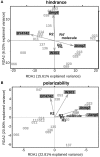Relations between Effects and Structure of Small Bicyclic Molecules on the Complex Model System Saccharomyces cerevisiae
- PMID: 28424620
- PMCID: PMC5371657
- DOI: 10.3389/fphar.2017.00170
Relations between Effects and Structure of Small Bicyclic Molecules on the Complex Model System Saccharomyces cerevisiae
Abstract
The development of compounds able to modify biological functions largely took advantage of parallel synthesis to generate a broad chemical variance of compounds to be tested for the desired effect(s). The budding yeast Saccharomyces cerevisiae is a model for pharmacological studies since a long time as it represents a relatively simple system to explore the relations among chemical variance and bioactivity. To identify relations between the chemical features of the molecules and their activity, we delved into the effects of a library of small compounds on the viability of a set of S. cerevisiae strains. Thanks to the high degree of chemical diversity of the tested compounds and to the measured effect on the yeast growth rate, we were able to scale-down the chemical library and to gain information on the most effective structures at the substituent level. Our results represent a valuable source for the selection, rational design, and optimization of bioactive compounds.
Keywords: Saccharomyces cerevisiae; drug development; drug screening; high-throughput screening (HTS); phenotypic screening; principal component analysis; small compounds; stepwise regression analysis.
Figures






Similar articles
-
Chemical genetics approach to identify new small molecule modulators of cell growth by phenotypic screening of Saccharomyces cerevisiae strains with a library of morpholine-derived compounds.Org Biomol Chem. 2010 Dec 21;8(24):5552-7. doi: 10.1039/c0ob00357c. Epub 2010 Oct 15. Org Biomol Chem. 2010. PMID: 20949215
-
The Budding Yeast "Saccharomyces cerevisiae" as a Drug Discovery Tool to Identify Plant-Derived Natural Products with Anti-Proliferative Properties.Evid Based Complement Alternat Med. 2011;2011:954140. doi: 10.1093/ecam/nep069. Epub 2011 Jun 23. Evid Based Complement Alternat Med. 2011. PMID: 19596744 Free PMC article.
-
Two low complexity ultra-high throughput methods to identify diverse chemically bioactive molecules using Saccharomyces cerevisiae.Microbiol Res. 2017 Jun;199:10-18. doi: 10.1016/j.micres.2017.02.004. Epub 2017 Feb 21. Microbiol Res. 2017. PMID: 28454705
-
Saccharomyces cerevisiae - Insects Association: Impacts, Biogeography, and Extent.Front Microbiol. 2020 Jul 14;11:1629. doi: 10.3389/fmicb.2020.01629. eCollection 2020. Front Microbiol. 2020. PMID: 32760380 Free PMC article. Review.
-
Technological advances in high-throughput screening.Am J Pharmacogenomics. 2004;4(4):263-76. doi: 10.2165/00129785-200404040-00006. Am J Pharmacogenomics. 2004. PMID: 15287820 Review.
References
-
- Bajorath J. (2013). Structure–activity relationship data analysis: activity landscapes and activity cliffs, in Diversity-Oriented Synthesis: Basics and Applications in Organic Synthesis, Drug Discovery, and Chemical Biology, ed Trabocchi A. (Hoboken, NJ: John Wiley and Sons; ), 507–531.

